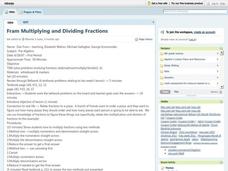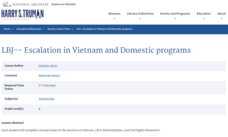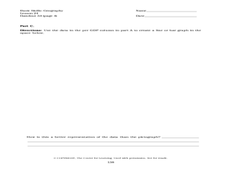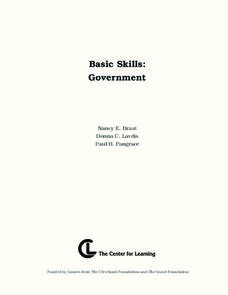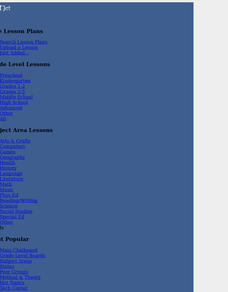Curated OER
Mesoamerica
Young scholars demonstrate knowledge of early Middle American civilizations. They study Mesoamerican i religions, governments, and achievements. They identify geographies of North and South America.
Curated OER
Indus Valley Geography and Civilization
High schoolers study the geographical features of the Indus Valley to determine how the location of this valley contributed to the growth of an ancient civilization. They work in groups to research the area before completing map work...
Curated OER
Applications of Cargoes from Three Continents to the Latin Classroom
Students discuss the importance of communication and writing in their daily lives. In groups, they use the internet to research the development of letters, alphabets and writing materials. They trace the spread of the Latin language...
Curated OER
Multiplying Fractions
Students investigate the concept of multiplying fractions and use the inverse for doing division. They practice working the problems with scaffolding provided by examples with the teacher. The link is made to real life with the...
Curated OER
LBJ-- Escalation in Vietnam and Domestic Programs
Eighth graders investigate the Vietnam War. In this Vietnam War lesson, 8th graders research the escalation of the war during Lyndon Johnson's presidency. Students also explore the domestic programs that Johnson promoted. Students...
Curated OER
Baby Boom and the Culture of the 1950's
Eleventh graders explain the causes, course, and consequences of the United States' role in World War II.
Curated OER
Population and Population Density
Students read and interpret graphs. For this population lesson, students explore population and population density as they read several data graphs and respond to questions.
Curated OER
The Rise of Islam
Young scholars read their textooks and discuss in groups the background of Muhammad answering oral questions and studying and identifying Mecca on the map. They work in groups to read handouts on "Early Revelations of Muhammad" to...
Curated OER
Using and Creating Timelines
Eleventh graders analyze information presented in a timeline and then create a time line. They put the following events in order from oldest to recent: Telephone invented (1876), Massacre at Wounded Knee (1890), First transcontinental...
Curated OER
Primary and Secondary Sources
Learners understand what primary and secondary sources are. In this primary and secondary sources lesson plan, students take a list of sources and break down to primary and secondary sources.
Curated OER
The Bill of Rights
Pupils classify the Bill of Rights. In this U.S. Constitution lesson, students complete provided readings and worksheets in order to define, identify and analyze each of the amendments and explain why they were included in the...
Curated OER
Lead Up to World War II
Twelfth graders examine Hitler's rise to power leading up to World War II. and how the Treaty of Versailles contributed to Hitler's rise to power in Germany. They identify the important countries involved in the beginning of World War II.
Curated OER
Journalism in the Halls
Students examine the Lane Tech murals on the Web or at the school. They conduct interviews with students and professionals as a method of researching the subjects of these murals. They write an article for a special "mural" edition of...
Curated OER
Civil Liberties and National Security
High schoolers identify the civil liberties outlined in the U.S. Bill of Rights and discuss the importance of these liberties in today's society. They research examples of when Congress has taken legislative action to protect national...
Curated OER
First Nations: Analysing Sources
Ninth graders examine the lifestyle and culture of First Nations people. They investigate and analyze primary and secondary source documents.
Curated OER
Why Was the United States Filled With Self-Doubt at the End of the Carter Administration?
High schoolers research the events of the 1960s and 1970s using the internet. In groups, they draw their own political cartoons about one of the events. They also write a summary about how one specific event of their choosing gave the...
Curated OER
Natural Selection
Eighth graders define natural selection and adaptation. They simulate natural selection within a species and relate the elements of natural selection to the simulation. They analyze the results of natural selection in terms of...
Curated OER
The Sugar Cane Curtain/ Defining Political and Social Struggles Between Haiti and the Dominican Republic
Twelfth graders explore historical events that created conflict between Dominican Republic and Haiti, examine how need for cheap source of labor has led to exploitation of Haitian workers, and discuss how topography of island of...
Curated OER
Science: Finlay and Yellow Fever
Ninth graders research the work of Carlos J. Finlay and his contributions to science. Once they have discussed his theories about diseases, they create tables comparing diseases that use insects as carriers. The lesson also includes a...
Curated OER
Diversity of Mammals
In this mammals worksheet, students compare and contrast the three types of mammals: placental, marsupial, and monotreme. This worksheet has 4 short answer, 12 matching, and 8 fill in the blank questions.
Curated OER
Protists
In this protists learning exercise, students compare and contrast the different types of funguslike protists: slime molds, water molds, and downy mildews. This learning exercise has 1 short answer and 7 fill in the blank questions.
Curated OER
America's Wars
Students classify information regarding American involvement in wars. In this classification lesson, students examine the causes of the war in which the United States has been involved, and classify them as mainly political, social,...
Curated OER
The Lewis and Clark Expedition
Students examine the Lewis and Clark expedition. They develop skills for historical analysis. They locate a variety of geographic features encountered by the expedition, and create a timeline that documents Lewis and Clark on their journey.
Curated OER
The American Civil War Conflict Begins
Tenth graders get a feel for the people behind the American Civil War and the beginning of the conflict. discuss some of the reasons the Confederate and Union soldier fought and explain the motives behind moves made by both the Union and...



